| Pangka mill was one of my favourite mills in Java. Although there was no field work the operation was sufficient to require three of four engines to be in steam and the engine shed is a particularly evocative location. Pangka is one of two 600mm mills which are located to the south of Tegal. Most, if not all, of the cut sugar cane is brought to the mills by lorry and then loaded onto railway wagons for the final journey into the crushing plant. This presumably prevents the lorries having to wait many hours to offload and allows the mills to process the cut cane both day and night. During my two visits in 2004 and 2006 the loaded wagons were hauled into the mill from the road delivery yard by locomotives operating boiler first and therefore presenting far more in the way of photographic opportunities than at mills such as Tersana Baru or Sragi. At Pangka mill there seemed to be a determined effort to promote the heritage aspect of their steam locomotives. A large sign at the entrance to the mill informed visitors of this fact, although it featured a somewhat incongruous picture of an American 'smokestack' locomotive, and a well illustrated pamphlet and guide book were readily available to the visitor. Pangka's locomotive fleet seemed particularly well kept and the engines sported a most attractive deep red livery with highly polished number and builders plates. Latest reports (June 2011) suggest that steam is still in use at Pangka although it may be wise to visit later in the season rather than at the beginning of the 'season'. It is also worth the price of entry to view the remaining stationary steam engines which are still used within the mill itself. For pictures see Rob Dickinson's report from 2010 |

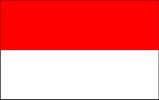
| PANGKA TEGAL REGION |
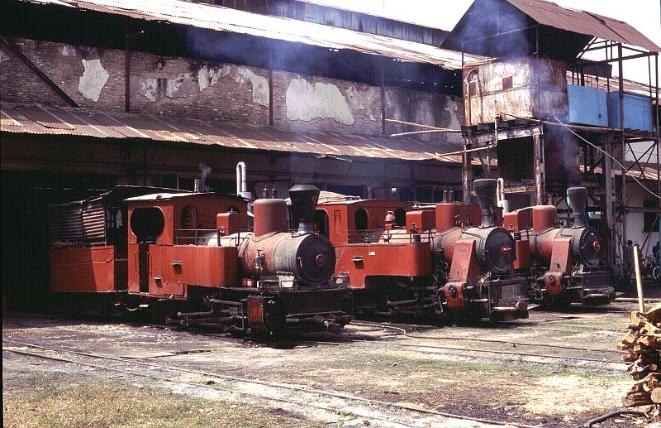
Early afternoon at Pangka and
following the morning activities the
locomotives return to the shed
prior to a second burst of activity
in the afternoon. Seen here (left to
right) are:
O & K 0-8-0T No.9 (built 1914)
Jung 0-6-2T No.3 (built 1920) and
Jung 0-6-2T No.2 (built 1915)
following the morning activities the
locomotives return to the shed
prior to a second burst of activity
in the afternoon. Seen here (left to
right) are:
O & K 0-8-0T No.9 (built 1914)
Jung 0-6-2T No.3 (built 1920) and
Jung 0-6-2T No.2 (built 1915)
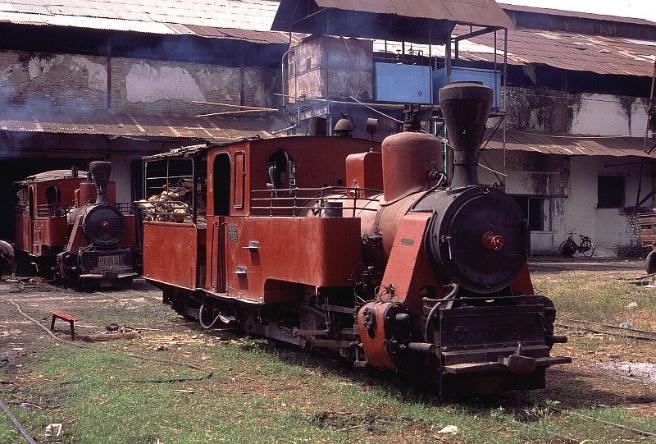
Jung 0-6-2T No.1 (built 1915)
stands outside of the shed at
Pangka. There are four of these
delightful machines at the mill
although No.5 was not in use
during either of my visits
stands outside of the shed at
Pangka. There are four of these
delightful machines at the mill
although No.5 was not in use
during either of my visits
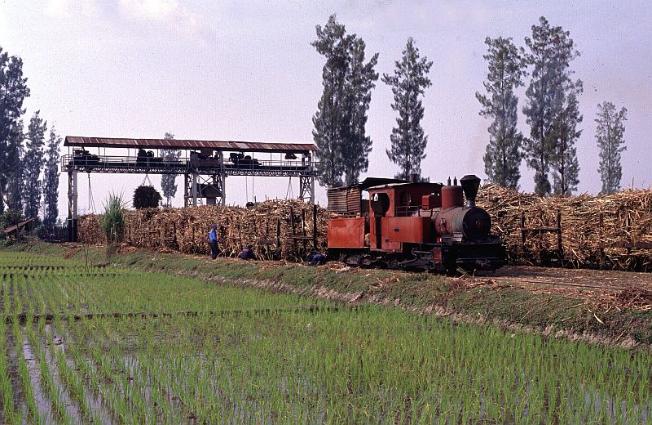
Prior to the planting of a line of
trees sometime between my visit in
2004 and the return visit in 2006 it
was possible to photograph trains
in the road delivery yard from
across the paddy fields. This was a
somewhat hazardous location as
recounted in my trip report for
2004 (see separate page)
Orenstein & Koppel 0-8-0T No.9 is
preparing to take a train of loaded
wagons from the road delivery
yard to the mill yard - a journey of
about 800 yards or so.
trees sometime between my visit in
2004 and the return visit in 2006 it
was possible to photograph trains
in the road delivery yard from
across the paddy fields. This was a
somewhat hazardous location as
recounted in my trip report for
2004 (see separate page)
Orenstein & Koppel 0-8-0T No.9 is
preparing to take a train of loaded
wagons from the road delivery
yard to the mill yard - a journey of
about 800 yards or so.
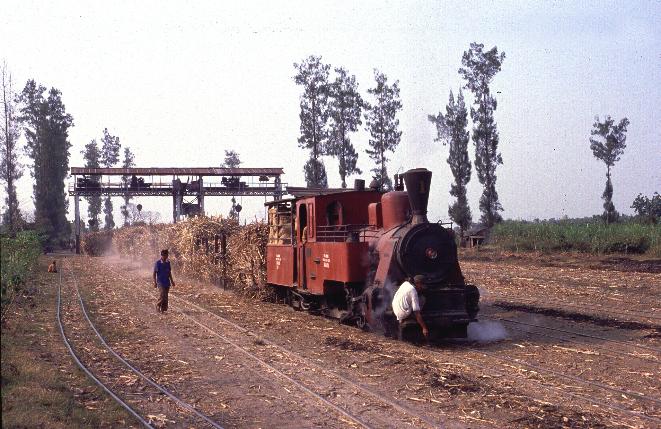
Jung 0-6-2T No.1 attempts to haul
a heavily loaded train away from
the road delivery yard in August
2006. To assist with traction hand
sanding is carried out with
apparent disregard for personal
health and safety!
a heavily loaded train away from
the road delivery yard in August
2006. To assist with traction hand
sanding is carried out with
apparent disregard for personal
health and safety!
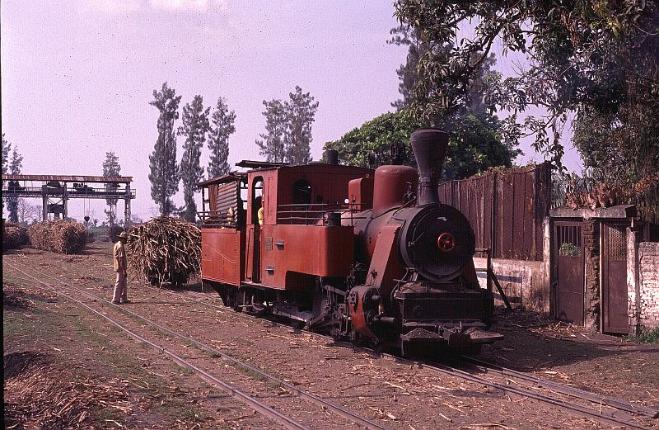
Jung 0-6-2T No.2 engages in a
little light shunting in the road
delivery yard at Pangka
little light shunting in the road
delivery yard at Pangka
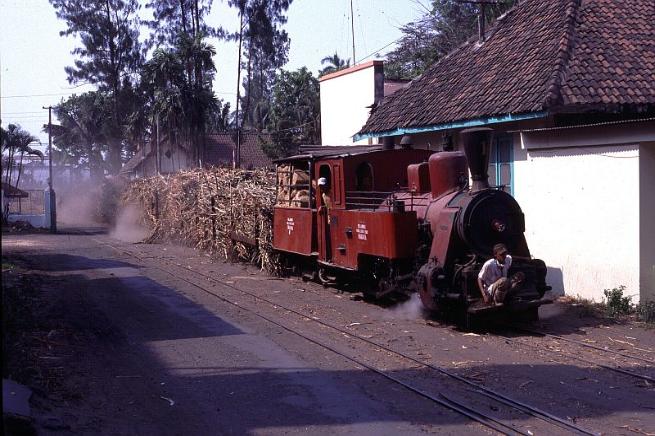
Jung 0-6-2T No.1 hauling its train
of loaded wagons from the road
delivery yard to the main mill yard.
This involves crossing a main road
and running between the mill
buildings which provides for some
interesting photographic
opportunities
of loaded wagons from the road
delivery yard to the main mill yard.
This involves crossing a main road
and running between the mill
buildings which provides for some
interesting photographic
opportunities
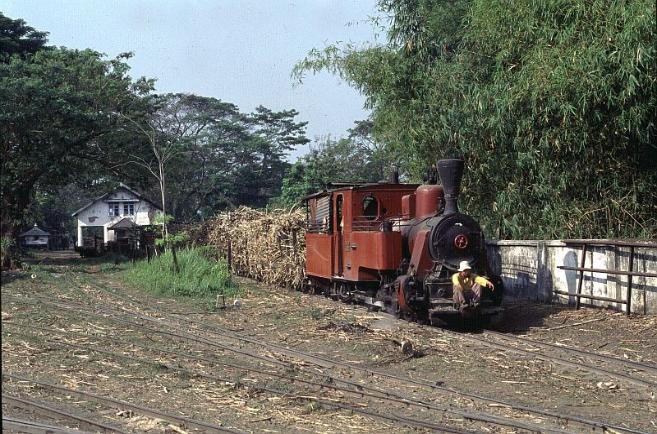
Jung 0-6-2T No.2 further along the
journey described above having just
passed the weighbridge which
stands on the left of this shot.
Sitting on the front buffer beam is
the sanding apparatus!
journey described above having just
passed the weighbridge which
stands on the left of this shot.
Sitting on the front buffer beam is
the sanding apparatus!
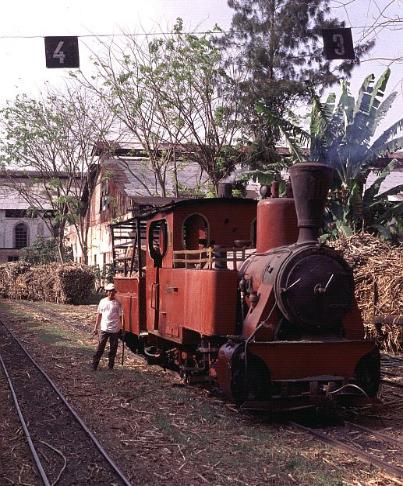
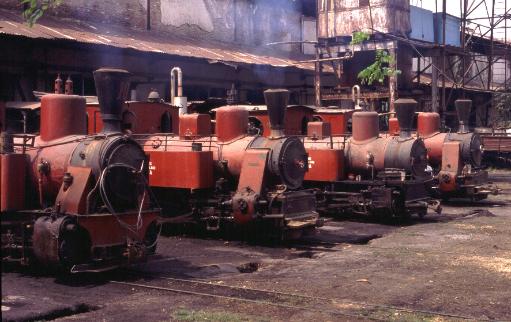
Another shot of locomotives standing outside of the shed at Pangka - on
this occasion the line up comprises of two Orenstein & Koppel 0-8-0T's
Nos. 9 and 10 together with two Jung 0-6-2's Nos. 1 and 2 (above)
Orenstein & Koppel No.10 pauses between shunting duties in the main
mill yard. The loaded loris are propelled back into the mill where they
are offloaded into the cane crusher as the rendering process begins (right)
this occasion the line up comprises of two Orenstein & Koppel 0-8-0T's
Nos. 9 and 10 together with two Jung 0-6-2's Nos. 1 and 2 (above)
Orenstein & Koppel No.10 pauses between shunting duties in the main
mill yard. The loaded loris are propelled back into the mill where they
are offloaded into the cane crusher as the rendering process begins (right)
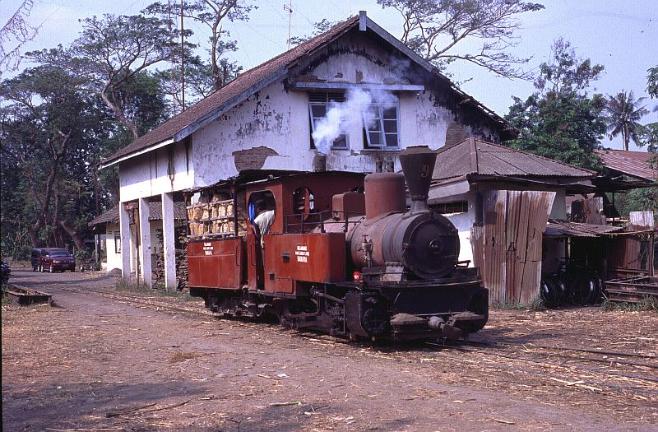
Orenstein & Koppel No.9 runs light
engine past the weighbridge in the
mill yard at Pangka
engine past the weighbridge in the
mill yard at Pangka
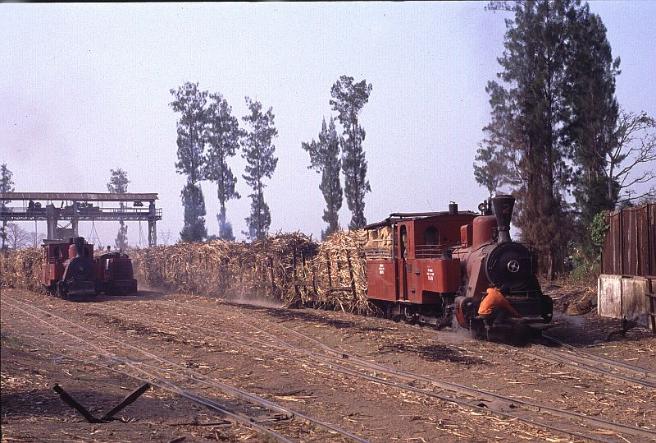
Jung 0-6-2T No. 2 departs from the
road delivery yard with a loaded
train of sugar cane bound for the
mill yard as Jung No.1 and one of
the diesel locomotives stand in the
background in August 2006
road delivery yard with a loaded
train of sugar cane bound for the
mill yard as Jung No.1 and one of
the diesel locomotives stand in the
background in August 2006
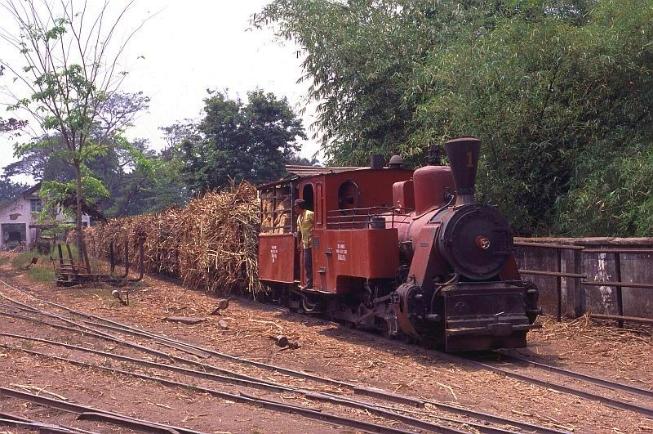
Jung 0-6-2 No.1 brings a train
from the road delivery yard
towards the mill yard. The train
will come to a stand about 200
yards further on before reversing
the wagons back into the mill yard
from the road delivery yard
towards the mill yard. The train
will come to a stand about 200
yards further on before reversing
the wagons back into the mill yard
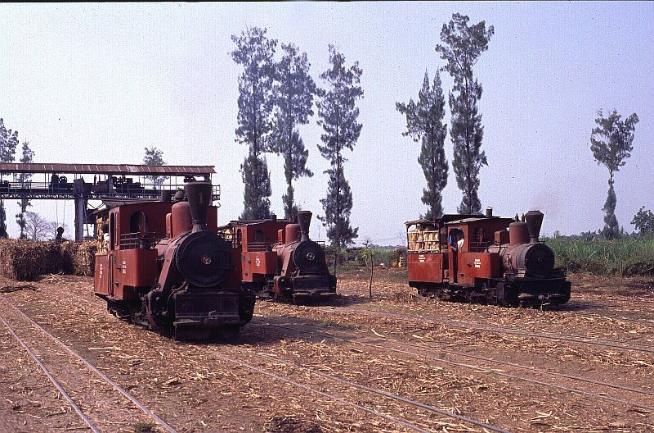
A wonderful line up of locomotives
in the yard at Pangka with locos
No.1, 2 and 9 awaiting their turn to
bring in trains of loaded wagons.
in the yard at Pangka with locos
No.1, 2 and 9 awaiting their turn to
bring in trains of loaded wagons.
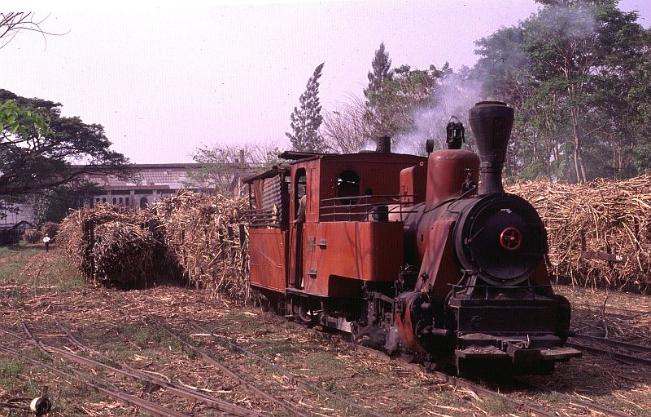
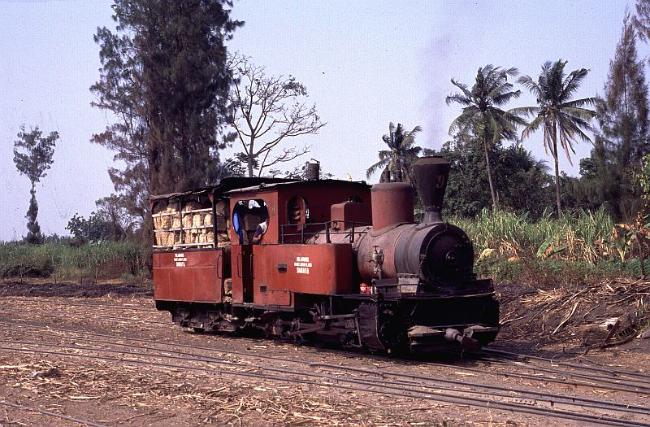
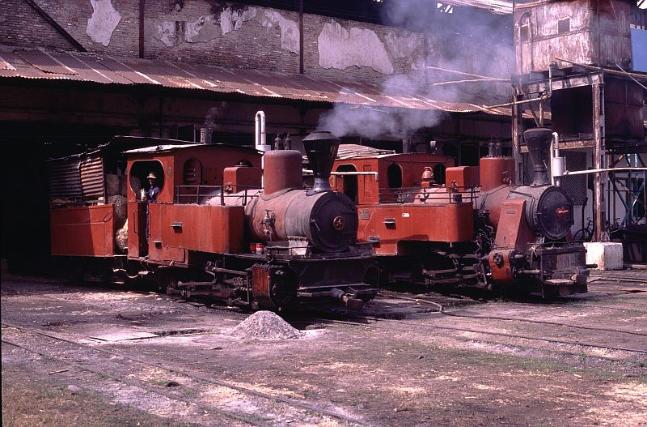
Pangka No.2 shunting cane wagons
in the main mill yard
in the main mill yard
Pangka No.9 standing in the road
delivery yard with its auxiliary
tender loaded to the roof with
bagasse - the waste product from
the crushing of the sugar cane
which is dried and used as a fuel
source for locomotives and the
furnaces within the sugar mill
delivery yard with its auxiliary
tender loaded to the roof with
bagasse - the waste product from
the crushing of the sugar cane
which is dried and used as a fuel
source for locomotives and the
furnaces within the sugar mill
The yard in front of the shed was a
wonderful place to photograph the
locos as they prepared for the next
shift or returned for minor repairs.
The similarities and differences
between the 0-8-0T Orenstein &
Koppels and the 0-6-2T Jung
locomotives can be clearly seen as
No. 9 and No. 3 wait their next
duties.
wonderful place to photograph the
locos as they prepared for the next
shift or returned for minor repairs.
The similarities and differences
between the 0-8-0T Orenstein &
Koppels and the 0-6-2T Jung
locomotives can be clearly seen as
No. 9 and No. 3 wait their next
duties.